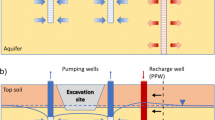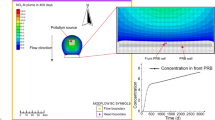Abstract
This purpose of this study was to evaluate the impact of heterogeneity in aquifer hydraulic conductivity on configurations of non-pumped wells filled with reactive media for removing contaminant plumes in groundwater. Among one homogeneous and three heterogeneous simulated aquifers, 2–16 wells were necessary to contain a plume, with no clear relationship between degree of heterogeneity and number of wells. Generally, heterogeneous aquifers with initial plumes having broad rather than narrow downgradient margins required more wells and showed greater tendency for plumes to move around wells. Cleanup time increased up to 181 % with degree of heterogeneity in hydraulic conductivity.




Similar content being viewed by others
References
Blowes DW, Ptacek CJ, Benner SG, McRae CWT, Puls RW (2000) Treatment of inorganic contaminants using permeable reactive barriers. J Contaminant Hydrol 45(1):123–137
Conca JL, Wright J (2006) An apatite II permeable reactive barrier to remediate groundwater containing Zn, Pb and Cd. Applied Geochem 21(12):2188–2200
Freethey GW, Naftz DL, Rowland RC, Davis JA (2002) Deep aquifer remediation tools: theory, design, and performance modeling. In: Naftz DL, Morrison SJ, Davis JA, Fuller CC (eds) Handbook of groundwater remediation using permeable reactive barriers. Academic Press, Amsterdam, pp 133–161
Guerin TF, Horner S, McGovern T, Davey B (2002) An application of permeable reactive barrier technology to petroleum hydrocarbon contaminated groundwater. Water Res 36(1):15–24
Hudak PF (2008) Evaluation of reactive wells networks for remediating heterogeneous aquifers. J Environ Sci Health 43:731–737
Lai KCK, Lo IMC, Birkelund V, Kjeldsen P (2006) Field monitoring of a permeable reactive barrier for removal of chlorinated organics. J Environ Eng 132(2):199–210
Ludwig RD, McGregor RG, Blowes DW, Benner SG, Mountjoy K (2002) A permeable reactive barrier for treatment of heavy metals. Ground Water 40(1):59–66
Morgan LA, Ficklen D, Knowles M (2005) Site characterization to support permeable reactive barrier design. Remediation 15(4):63–71
NRC (National Research Council) (1994) Alternatives for ground water cleanup. National Academy Press, Washington, DC
Puls RW, Paul CJ, Powell RM (1999) The application of in situ permeable reactive (zero-valent) barrier technology for the remediation of chromate-contaminated groundwater: a field test. Appl Geochem 14:989–1000
Robertson WD, Blowes DW, Cherry JA (2000) Long-term performance of in situ reactive barriers for nitrate remediation. Ground Water 38(5):689–695
USGS (US Geological Survey) (1999) Deep aquifer remediation tools (DARTs): a new technology for ground-water remediation. US geological survey fact sheet 156-99, Reston, Virginia
Vogan JL, Focht RM, Clark DK, Graham SL (1999) Performance evaluation of a permeable reactive barrier for remediation of dissolved chlorinated solvents in groundwater. J Hazard Mater 68(1):97–108
Zheng C, Wang PP (1999) MT3DMS, a modular three-dimensional multi-species transport model for simulation of advection, dispersion and chemical reactions of contaminants in groundwater systems; documentation and user’s guide. US Army Engineer Research and Development Center Contract Report SERDP-99-1, Vicksburg, MS
Author information
Authors and Affiliations
Corresponding author
Rights and permissions
About this article
Cite this article
Hudak, P.F. Effect of Aquifer Heterogeneity on Non-pumped, Reactive Well Networks for Removing Pollutants in Groundwater. Bull Environ Contam Toxicol 88, 997–1000 (2012). https://doi.org/10.1007/s00128-012-0605-z
Received:
Accepted:
Published:
Issue Date:
DOI: https://doi.org/10.1007/s00128-012-0605-z




